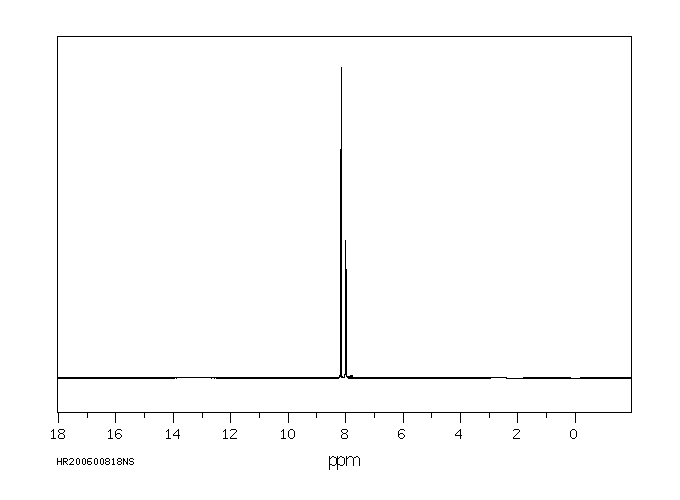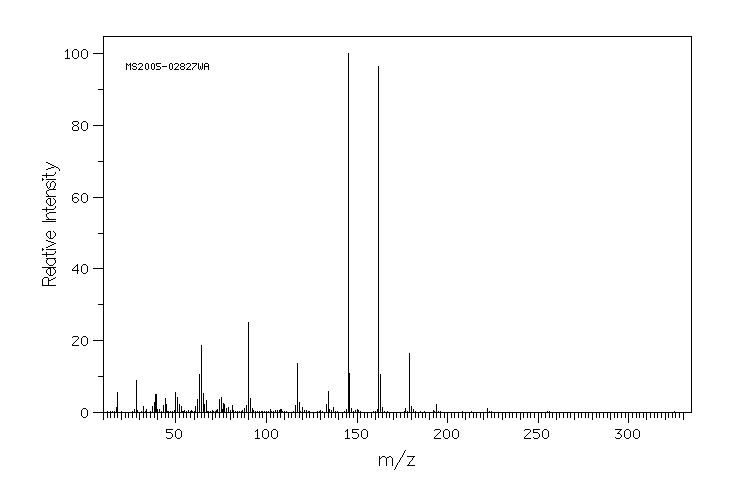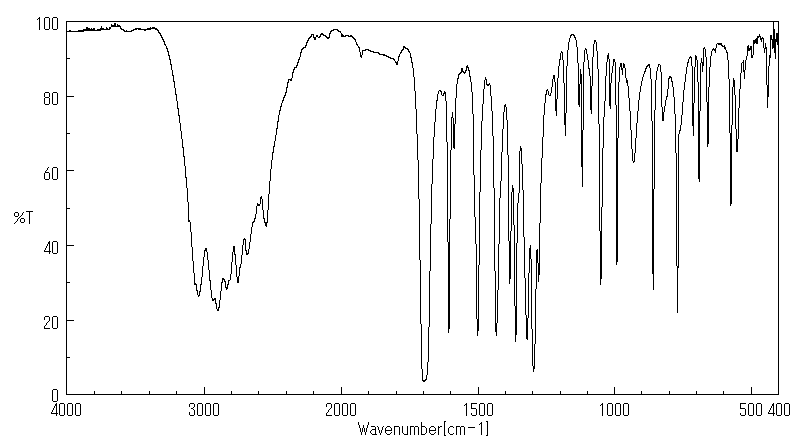1-(4-羧苯基)-5-巯基-1H-四唑 | 23249-95-8
-
物化性质
-
计算性质
-
ADMET
-
安全信息
-
SDS
-
制备方法与用途
-
上下游信息
-
文献信息
-
表征谱图
-
同类化合物
-
相关功能分类
-
相关结构分类
物化性质
-
沸点:385.2±44.0 °C(Predicted)
-
密度:1.67±0.1 g/cm3(Predicted)
-
稳定性/保质期:
计算性质
-
辛醇/水分配系数(LogP):2.3
-
重原子数:15
-
可旋转键数:2
-
环数:2.0
-
sp3杂化的碳原子比例:0.0
-
拓扑面积:109
-
氢给体数:2
-
氢受体数:5
安全信息
-
危险等级:4.1
-
WGK Germany:3
-
海关编码:2933990090
-
安全说明:S24/25
-
包装等级:II
-
危险类别:4.1
-
危险性防范说明:P240,P210,P241,P280,P370+P378
-
危险品运输编号:1325
-
危险性描述:H228
SDS
模块 1. 化学品
产品名称: 1-(4-Carboxyphenyl)-5-mercapto-1H-tetrazole
修改号码: 5
模块 2. 危险性概述
GHS分类
物理性危害
易燃固体 第1级
健康危害 未分类
环境危害 未分类
GHS标签元素
图标或危害标志
信号词 危险
危险描述 易燃固体
防范说明
[预防] 远离热源/火花/明火/热表面。禁烟。
使用防爆的电气/通风/照明设备。
穿戴防护手套/护目镜/防护面具。
模块 3. 成分/组成信息
单一物质/混和物 单一物质
化学名(中文名): 1-(4-羧苯基)-5-巯基-1H-四唑
百分比: >95.0%(LC)(T)
CAS编码: 23249-95-8
俗名: 1-(4-Carboxyphenyl)-1H-tetrazole-5-thiol , 4-(5-Mercapto-1H-tetrazol-1-
yl)benzoic Acid
分子式: C8H6N4O2S
模块 4. 急救措施
吸入: 将受害者移到新鲜空气处,保持呼吸通畅,休息。若感不适请求医/就诊。
1-(4-羧苯基)-5-巯基-1H-四唑 修改号码:5
模块 4. 急救措施
皮肤接触: 立即去除/脱掉所有被污染的衣物。用水清洗皮肤/淋浴。
若皮肤刺激或发生皮疹:求医/就诊。
眼睛接触: 用水小心清洗几分钟。如果方便,易操作,摘除隐形眼镜。继续清洗。
如果眼睛刺激:求医/就诊。
食入: 若感不适,求医/就诊。漱口。
紧急救助者的防护: 救援者需要穿戴个人防护用品,比如橡胶手套和气密性护目镜。
模块 5. 消防措施
合适的灭火剂: 干粉,泡沫,雾状水,二氧化碳
特殊危险性: 一旦发生火警,有爆炸的危险。由于爆炸的危险,远距离灭火。
小心,燃烧或高温下可能分解产生毒烟。
特定方法: 从上风处灭火,根据周围环境选择合适的灭火方法。
非相关人员应该撤离至安全地方。
周围一旦着火:喷水,保持容器冷却。如果安全,消除一切火源。
消防员的特殊防护用具: 灭火时,一定要穿戴个人防护用品。
模块 6. 泄漏应急处理
个人防护措施,防护用具, 使用个人防护用品。远离溢出物/泄露处并处在上风处。
紧急措施: 泄露区应该用安全带等圈起来,控制非相关人员进入。
环保措施: 防止进入下水道。
控制和清洗的方法和材料: 清扫收集粉尘,封入密闭容器。注意切勿分散。附着物或收集物应该立即根据合适的
法律法规处置。
副危险性的防护措施 移除所有火源。一旦发生火灾应该准备灭火器。使用防火花工具和防爆设备。
模块 7. 操作处置与储存
处理
技术措施: 在通风良好处进行处理。穿戴合适的防护用具。切勿引起泄漏、溢出或分散。切勿产
生不必要的蒸气。远离热源/火花/明火/热表面。禁烟。采取措施防止静电积累。使用
防爆设备。避免冲击和摩擦。处理后彻底清洗双手和脸。
注意事项: 如果粉尘或浮质产生,使用局部排气。
操作处置注意事项: 避免接触皮肤、眼睛和衣物。
贮存
储存条件: 保持容器密闭。存放于凉爽、阴暗处。
存放于惰性气体环境中。
确保容器不会受到未测影响,比如跌落或脱落。
远离不相容的材料比如氧化剂存放。
气敏
包装材料: 依据法律。
模块 8. 接触控制和个体防护
工程控制: 尽可能安装封闭体系或局部排风系统。同时安装淋浴器和洗眼器。
个人防护用品
呼吸系统防护: 防尘面具。依据当地和政府法规。
手部防护: 防护手套。
眼睛防护: 安全防护镜。如果情况需要,佩戴面具。
皮肤和身体防护: 防护服。如果情况需要,穿戴防护靴。
模块 9. 理化特性
固体
外形(20°C):
1-(4-羧苯基)-5-巯基-1H-四唑 修改号码:5
模块 9. 理化特性
外观: 晶体-粉末
颜色: 白色-微浅黄色
气味: 无资料
pH: 无数据资料
熔点: 无资料
沸点/沸程 无资料
闪点: 无资料
爆炸特性
爆炸下限: 无资料
爆炸上限: 无资料
密度: 无资料
溶解度:
[水] 无资料
[其他溶剂] 无资料
模块 10. 稳定性和反应性
化学稳定性: 一般情况下稳定。
危险反应的可能性: 热、撞击、摩擦等条件下可能爆炸分解。
避免接触的条件: 热, 火花, 明火, 静电, 冲击, 摩擦
须避免接触的物质 氧化剂
危险的分解产物: 一氧化碳, 二氧化碳, 氮氧化物 (NOx), 硫氧化物
模块 11. 毒理学信息
急性毒性: 无资料
对皮肤腐蚀或刺激: 无资料
对眼睛严重损害或刺激: 无资料
生殖细胞变异原性: 无资料
致癌性:
IARC = 无资料
NTP = 无资料
生殖毒性: 无资料
模块 12. 生态学信息
生态毒性:
鱼类: 无资料
甲壳类: 无资料
藻类: 无资料
残留性 / 降解性: 无资料
潜在生物累积 (BCF): 无资料
土壤中移动性
log水分配系数: 无资料
土壤吸收系数 (Koc): 无资料
亨利定律 无资料
constaNT(PaM3/mol):
模块 13. 废弃处置
如果可能,回收处理。请咨询当地管理部门和专家。建议在可燃溶剂中溶解混合,然后在装有后燃和洗涤装置的化
学焚烧炉中慢慢焚烧。如果一次性焚烧大量物质,可能发生爆炸。废弃处置时请遵守国家、地区和当地的所有法规
。
1-(4-羧苯基)-5-巯基-1H-四唑 修改号码:5
模块 14. 运输信息
联合国分类: 第1项 易燃固体。
UN编号: 1325
正式运输名称: 可燃固体, 有机的, 不另作详细说明.
包装等级: II
模块 15. 法规信息
《危险化学品安全管理条例》(2002年1月26日国务院发布,2011年2月16日修订): 针对危险化学品的安全使用、
生产、储存、运输、装卸等方面均作了相应的规定。
模块16 - 其他信息
N/A
制备方法与用途
上下游信息
反应信息
-
作为反应物:描述:1-(4-羧苯基)-5-巯基-1H-四唑 在 sodium tungstate (VI) dihydrate 、 双氧水 、 N,N-二异丙基乙胺 作用下, 以 四氢呋喃 、 乙醇 、 水 为溶剂, 反应 30.58h, 生成 4-(5-(methylsulfonyl)-1H-tetrazol-1-yl)benzoic acid参考文献:名称:可调杂芳族砜增强细胞内半胱氨酸分析摘要:杂芳族砜通过亲核芳香取代与半胱氨酸反应,为半胱氨酸缀合提供机械选择性和不可逆支架。在这里,我们评估了具有不同氧化态、杂原子取代和一系列给电子和吸电子取代基的杂芳族硫化物库。与传统的半胱氨酸偶联试剂相比,选择取代对反应性和稳定性产生了深远的影响,将反应速率提高了 > 3 个数量级。研究结果建立了一系列可合成的可跨多个可调中心可调的亲电支架。新的亲电子试剂及其相应的炔烃偶联物直接在培养的细胞中进行分析,在几分钟内以亚毫摩尔浓度实现硫醇饱和。将脱硫生物素功能化探针直接添加到培养细胞中简化了富集和洗脱,从而能够在标准分析时间的一小部分内通过质谱发现在其天然细胞环境中标记的 >3000 个反应性和/或可接近的硫醇。令人惊讶的是,在重复实验中,只有 1/2 的注释半胱氨酸被碘乙酰胺-脱硫生物素和甲基磺酰基苯并噻唑-脱硫生物素鉴定,证明了质谱分析的互补检测。与现有的半胱氨酸烷基化试剂相比,这些探针具有优DOI:10.1021/jacs.9b08831
-
作为产物:描述:参考文献:名称:COMPOUNDS THAT SELECTIVELY AND EFFECTIVELY INHIBIT HAKAI-MEDIATED UBIQUITINATION, AS ANTI-CANCER DRUGS摘要:本发明提供了一类化合物,其中包括对映体和其药学上可接受的盐,能够选择性和有效地抑制Hakai介导的泛素化,优选地不影响Hakai蛋白水平,因此代表了出色的抗癌药物,可用于治疗多种癌症,特别是从胃肠道上皮层发生的肿瘤,包括口腔癌、食管癌、胃癌、小肠和大肠(如直肠或结肠癌),还包括皮肤癌、乳腺癌、胰腺癌、肺癌、头颈癌、肝癌、卵巢癌、宫颈癌、子宫癌、胆囊癌、阴茎癌和泌尿膀胱癌(如肾、前列腺或膀胱癌)。公开号:EP3653208A1
-
作为试剂:描述:硫酸 、 水 、 neodymium(III) nitrate hexahydrate 在 1-(4-羧苯基)-5-巯基-1H-四唑 作用下, 以 乙醇 为溶剂, 以53 %的产率得到neodymium(III) sulfate octahydrate参考文献:名称:硫酸钕基无机网络的合成、结构、结构转变和性能摘要:两种基于硫酸钕的纯无机网络,[NH 4 ][Nd(SO 4 ) 2 (H 2 O) 3 ] ⋅ H 2 O (1) 和 [Nd 2 (SO 4 ) 3 (H 2 O) 4 ] ⋅ H 2 O (2) 在不同的反应温度和 pH 值下合成。 1的结构具有二维(2D)阴离子波纹片,具有通过连接NdO 8 单元和μ 2 -SO 4 阴离子,其中 NH 4 + 电荷补偿/模板化阳离子占据片间层。而2拥有一个3D中性框架,具有前所未有的(3,4 2 ,7-c)网络,由NdO 9 单元和μ 4 - 和μ构建 6 -SO 4 2− 链接器。它们表现出与脱水以及配位几何和维度的变化相关的热诱导不可逆结构转变。化合物 1 和 2 都显示出 Nd 3+ 中心之间典型的反铁磁相互作用。此外,还研究了去溶剂化样品1和2的CO 2 吸附等温线。DOI:10.1002/zaac.202300161
文献信息
-
AFFINITY ILLUDOFULVENE CONJUGATES申请人:AF Chemicals, LLC,公开号:US20210155583A1公开(公告)日:2021-05-27In an embodiment of the invention, a composition for treating a cell population comprises a medicant. The medicant moiety can be an illudofulvene analog. In an embodiment of the invention, a composition for treating a cell population comprises an Affinity Medicant Conjugate (AMC). The affinity moiety can be an antibody, an antibody fragment, a receptor protein, a peptidic growth factor, an anti-angiogenic protein, a specific binding peptide, protease cleavable peptide, a glycopeptide, a peptide, a peptidic toxin, a protein toxin and an oligonucleotide. The affinity moiety can be covalently bound to the medicant via a linker.
-
Ordered heterogeneity of molecular photosensitizer toward enhanced photocatalysis作者:Ji-Hong Zhang、Yun-Nan Gong、Hong-Juan Wang、Yu-Chen Wang、Wei Yang、Jian-Hua Mei、Di-Chang Zhong、Tong-Bu LuDOI:10.1073/pnas.2118278119日期:2022.3.15
Significance The photosensitizer is one of the important components in the photocatalytic system. Molecular photosensitizers have well-defined structures, which is beneficial in revealing the catalysis mechanism and helpful for further structural design and performance optimization. However, separation and recycling of the molecular photosensitizers is a great problem. Loading them into/on two/three-dimensional supports through covalent bonds, electrostatic interactions, and supramolecular interactions is a method that enhances their separation and recycling capability. Nonetheless, the structures of the resulting composites are unclear. Thus, the development of highly crystalline heterogeneity methods for molecular photosensitizers, albeit greatly challenging, is meaningful and desirable in photocatalysis, through which heterogeneous photosensitizers with well-defined structures, definite catalysis mechanisms, and good catalytic performance would be expected.
意义 光敏剂是光催化系统中的重要组成部分之一。分子光敏剂具有明确定义的结构,这有助于揭示催化机理并有助于进一步的结构设计和性能优化。然而,分离和回收分子光敏剂是一个很大的问题。通过共价键、静电相互作用和超分子相互作用将它们加载到二/三维支撑体中是一种增强其分离和回收能力的方法。然而,所得复合材料的结构尚不清楚。因此,在光催化中,开发高度晶化的分子光敏剂异质性方法虽然极具挑战性,但具有意义和可取之处,通过这种方法,可以期望得到具有明确定义的结构、明确的催化机理和良好催化性能的异质光敏剂。
-
Self-Assembly and Characterization of a Novel 2D Network Polymer Containing a 60-Membered Organotin Macrocycle作者:Chunlin Ma、Qingfeng Wang、Rufen ZhangDOI:10.1021/ic800903s日期:2008.8.11-(4-carboxyphenyl)-5-mercapto-1 H-tetrazole with trimethyltin chloride in the presence of sodium ethoxide in benzene affords a novel 2D organotin network structure complex 1, which is an unusual organotin network containing a hexanuclear 60-membered organotin macrocycle. The complex has been characterized by elemental analysis, IR, and (1)H, (13)C, and (119)Sn NMR spectroscopy. Furthermore, we have
-
Silver halide color photographic light-sensitive material申请人:Fuji Photo Film Co., Ltd.公开号:US04628024A1公开(公告)日:1986-12-09A silver halide color photographic light-sensitive material comprising a support having thereon a silver halide emulsion layer and a compound represented by the following general formula (I): ##STR1## wherein COUP represents a coupler residue capable of being subjected to a coupling reaction with an oxidation product of an aromatic primary amine developing agent; TIME represents a timing group which is released upon the coupling reaction and subsequently releases ##STR2## Z represents a monocyclic or condensed heterocyclic ring consisting of a nitrogen atom and a carbon atom; L represents a divalent linking group; R.sup.1 represents a hydrogen atom or an alkoxycarbonyl group; R.sup.2 represents a hydrogen atom, an alkyl group, an aryl group, a heterocyclic group, an acyl group, a sulfonyl group, an alkoxycarbonyl group, a carbamoyl group, a sulfamoyl group, a thioacyl group or a thiocarbamoyl group; R.sup.3 represents a hydrogen atom; R.sup.2 and R.sup.3 may be bonded each other to form a hydrazone structure; a part of L and R.sup.1 may be bonded each other to form a hydrazone structure; and n represents 0 or 1. The silver halide color photographic light-sensitive material containing the compound capable of imagewise releasing a fogging agent represented by the general formula (I) is improved in stability during preservation and has a high contrast and sensitivity. A method of forming a color image using the silver halide color photographic light-sensitive material is also disclosed.一种银卤化物彩色摄影感光材料,包括支撑物上的银卤化物乳液层和下列一般式(I)所代表的化合物:##STR1##其中COUP代表能够与芳香族原始胺显影剂的氧化产物进行偶联反应的偶联剩基;TIME代表在偶联反应中释放并随后释放##STR2##的定时组;Z代表由一个氮原子和一个碳原子组成的单环或缩合杂环;L代表二价连结基;R.sUP.1代表氢原子或烷氧羰基基团;R.sUP.2代表氢原子、烷基、芳基、杂环基、酰基、磺酰基、烷氧羰基基团、氨基甲酰基基团、磺酰胺基基团、硫代酰基或硫代氨基甲酰基基团;R.sUP.3代表氢原子;R.sUP.2和R.sUP.3可以结合形成肼酮结构;L和R.sUP.1的一部分可以结合形成肼酮结构;n代表0或1。含有能够像图像地释放由一般式(I)所代表的雾化剂的化合物的银卤化物彩色摄影感光材料在保存期间具有较高的稳定性、对比度和灵敏度。还公开了使用该银卤化物彩色摄影感光材料形成彩色图像的方法。
-
Pharmaceutical Preparations Comprising Insulin, Zinc Ions and Zinc-Binding Ligand申请人:Kaarsholm Niels Christian公开号:US20090123563A1公开(公告)日:2009-05-14Novel preparations comprising branched ligands for the HisB10 Zn2+ sites of the R-state insulin hexamer. The preparations have a prolonged action designed for flexible injection regimes.
表征谱图
-
氢谱1HNMR
-
质谱MS
-
碳谱13CNMR
-
红外IR
-
拉曼Raman
-
峰位数据
-
峰位匹配
-
表征信息










